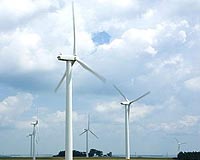 |
Palo Alto CA (SPX) Jun 19, 2009 In the future, will wind power tapped by high-flying kites light up New York? A new study by scientists at the Carnegie Institution and California State University identifies New York as a prime location for exploiting high-altitude winds, which globally contain enough energy to meet world demand 100 times over. The researchers found that the regions best suited for harvesting this energy match with population centers in the eastern U.S. and East Asia, but fluctuating wind strength still presents a challenge for exploiting this energy source on a large scale. Using 28 years of data from the National Center for Environmental Prediction and the Department of Energy, Ken Caldeira of the Carnegie Institution's Department of Global Ecology and Cristina Archer of California State University, Chico, compiled the first-ever global survey of wind energy available at high altitudes in the atmosphere. The researchers assessed potential for wind power in terms of "wind power density," which takes into account both wind speed and air density at different altitudes. "There is a huge amount of energy available in high altitude winds," said coauthor Ken Caldeira. "These winds blow much more strongly and steadily than near-surface winds, but you need to go get up miles to get a big advantage. Ideally, you would like to be up near the jet streams, around 30,000 feet." Jet streams are meandering belts of fast winds at altitudes between 20 and 50,000 feet that shift seasonally, but otherwise are persistent features in the atmosphere. Jet stream winds are generally steadier and 10 times faster than winds near the ground, making them a potentially vast and dependable source of energy. Several technological schemes have been proposed to harvest this energy, including tethered, kite-like wind turbines that would be lofted to the altitude of the jet streams. Up to 40 megawatts of electricity could be generated by current designs and transmitted to the ground via the tether. "We found the highest wind power densities over Japan and eastern China, the eastern coast of the United States, southern Australia, and north-eastern Africa," said lead author Archer. "The median values in these areas are greater than 10 kilowatts per square meter. This is unthinkable near the ground, where even the best locations have usually less than one kilowatt per square meter." Included in the analysis were assessments of high altitude wind energy for the world's five largest cities: Tokyo, New York, Sao Paulo, Seoul, and Mexico City. "For cities that are affected by polar jet streams such as Tokyo, Seoul, and New York, the high-altitude resource is phenomenal," said Archer. "New York, which has the highest average high-altitude wind power density of any U.S. city, has an average wind power density of up to 16 kilowatts per square meter." Tokyo and Seoul also have high wind power density because they are both affected by the East Asian jet stream. Mexico City and Sao Paulo are located at tropical latitudes, so they are rarely affected by the polar jet streams and just occasionally by the weaker sub-tropical jets. As a result they have lower wind power densities than the other three cities. "While there is enough power in these high altitude winds to power all of modern civilization, at any specific location there are still times when the winds do not blow," said Caldeira. Even over the best areas, the wind can be expected to fail about five percent of the time. "This means that you either need back-up power, massive amounts of energy storage, or a continental or even global scale electricity grid to assure power availability. So, while high-altitude wind may ultimately prove to be a major energy source, it requires substantial infrastructure." Share This Article With Planet Earth
Related Links Carnegie Institution Wind Energy News at Wind Daily
 Global Wind Day: Wind Energy Good, Community Wind Better
Global Wind Day: Wind Energy Good, Community Wind BetterMinneapolis MN (SPX) Jun 19, 2009 On June's Global Wind Day, sponsored by the Global Wind Energy Council (GWEC) and the American Wind Energy Association (AWEA), National Wind underscores the myriad benefits not only of wind energy but specifically of community-based development. Community wind projects have 5 times the local economic impact and 3.4 times the impact on local job creation of traditional, corporate wind farm ... read more |
|
| The content herein, unless otherwise known to be public domain, are Copyright 1995-2009 - SpaceDaily. AFP and UPI Wire Stories are copyright Agence France-Presse and United Press International. ESA Portal Reports are copyright European Space Agency. All NASA sourced material is public domain. Additional copyrights may apply in whole or part to other bona fide parties. Advertising does not imply endorsement,agreement or approval of any opinions, statements or information provided by SpaceDaily on any Web page published or hosted by SpaceDaily. Privacy Statement |